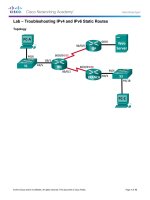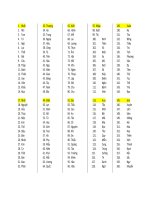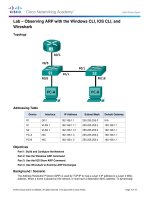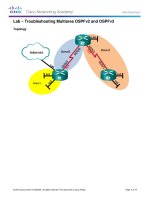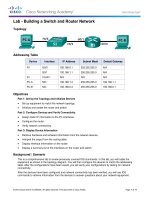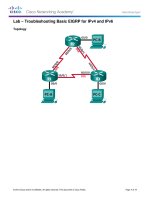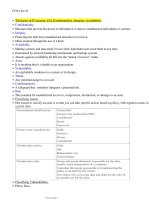Pearson CCNA routing and switching 200 125 exam cram 5th edition 0789756749 kho tài liệu bách khoa
Bạn đang xem bản rút gọn của tài liệu. Xem và tải ngay bản đầy đủ của tài liệu tại đây (18.85 MB, 703 trang )
About This E-Book
EPUB is an open, industry-standard format for e-books. However, support for EPUB
and its many features varies across reading devices and applications. Use your device
or app settings to customize the presentation to your liking. Settings that you can
customize often include font, font size, single or double column, landscape or portrait
mode, and figures that you can click or tap to enlarge. For additional information about
the settings and features on your reading device or app, visit the device manufacturer’s
Web site.
Many titles include programming code or configuration examples. To optimize the
presentation of these elements, view the e-book in single-column, landscape mode and
adjust the font size to the smallest setting. In addition to presenting code and
configurations in the reflowable text format, we have included images of the code that
mimic the presentation found in the print book; therefore, where the reflowable format
may compromise the presentation of the code listing, you will see a “Click here to view
code image” link. Click the link to view the print-fidelity code image. To return to the
previous page viewed, click the Back button on your device or app.
EXAM CRAM
CCNA Routing and Switching 200-125
Anthony Sequeira, CCIE No. 15626
800 East 96th Street
Indianapolis, Indiana 46240 USA
CCNA Routing and Switching 200-125 Exam Cram
Copyright © 2017 by Pearson Education, Inc.
All rights reserved. No part of this book shall be reproduced, stored in a retrieval
system, or transmitted by any means, electronic, mechanical, photocopying, recording,
or otherwise, without written permission from the publisher. No patent liability is
assumed with respect to the use of the information contained herein. Although every
precaution has been taken in the preparation of this book, the publisher and author
assume no responsibility for errors or omissions. Nor is any liability assumed for
damages resulting from the use of the information contained herein.
ISBN-13: 978-0-7897-5674-9
ISBN-10: 0-7897-5674-9
Library of Congress Control Number: 2016961093
Printed in the United States of America
First Printing: February 2017
Editor-in-Chief
Mark Taub
Product Line Manager
Brett Bartow
Development Editor
Christopher A. Cleveland
Managing Editor
Sandra Schroeder
Project Editor
Mandie Frank
Copy Editor
Christopher Morris
Indexer
Cheryl Lenser
Proofreader
Sathya Ravi
Technical Editor
Keith Barker
Publishing Coordinator Vanessa Evans
Designer
Chuti Prasertsith
Compositor
codeMantra
Trademarks
All terms mentioned in this book that are known to be trademarks or service marks have
been appropriately capitalized. Pearson IT Certification cannot attest to the accuracy of
this information. Use of a term in this book should not be regarded as affecting the
validity of any trademark or service mark.
Warning and Disclaimer
Every effort has been made to make this book as complete and as accurate as possible,
but no warranty or fitness is implied. The information provided is on an “as is” basis.
The author and the publisher shall have neither liability nor responsibility to any person
or entity with respect to any loss or damages arising from the information contained in
this book or from the use of the supplementary online content.
Special Sales
For information about buying this title in bulk quantities, or for special sales
opportunities (which may include electronic versions; custom cover designs; and content
particular to your business, training goals, marketing focus, or branding interests),
please contact our corporate sales department at or (800)
382-3419.
For government sales inquiries, please contact
For questions about sales outside the U.S., please contact
Contents at a Glance
Introduction
Part I: Network Fundamentals
CHAPTER 1 Network Fundamentals: Models and Designs
CHAPTER 2 Network Fundamentals: IPv4
CHAPTER 3 Network Fundamentals: IPv6
Part II: LAN Switching Technologies
CHAPTER 4 LAN Switching Technologies: Switching Concepts
CHAPTER 5 LAN Switching Technologies: VLANs, Trunks, and STP
CHAPTER 6 LAN Switching Technologies: EtherChannel and Switch Stacking
Part III: Routing Technologies
CHAPTER 7 Routing Technologies: Routing Concepts
CHAPTER 8 Routing Technologies: Inter-VLAN Routing
CHAPTER 9 Routing Technologies: Routing Methods
CHAPTER 10 Routing Technologies: Static Routing and Dynamic Routing
Part IV: WAN Technologies
CHAPTER 11 WAN Technologies: WAN Options
CHAPTER 12 WAN Technologies: eBGP
CHAPTER 13 WAN Technologies: QoS
Part V: Infrastructure Services
CHAPTER 14 Infrastructure Services: DNS, DHCP, NTP, HSRP
CHAPTER 15 Infrastructure Services: NAT
Part VI: Infrastructure Security
CHAPTER 16 Infrastructure Security: Access Layer Security, AAA
CHAPTER 17 Infrastructure Security: ACLs
CHAPTER 18 Infrastructure Security: Device Hardening
Part VII: Infrastructure Management
CHAPTER 19 Infrastructure Management: SNMP, Syslog, IP SLA
CHAPTER 20 Infrastructure Management: Device Management
CHAPTER 21 Infrastructure Management: Initial Device Configuration
CHAPTER 22 Infrastructure Management: Device Maintenance
CHAPTER 23 Infrastructure Management: IOS Troubleshooting Tools
CHAPTER 24 Infrastructure Management: Network Programmability
Part VIII: Command Reference, Practice Exams, and Glossary
Command Reference
Practice Exam 1
Answer Key to Practice Exam 1
Practice Exam 2
Answer Key to Practice Exam 2
Glossary
Index
To register this product and gain access to bonus content, go to
www.pearsonitcertification.com/register to sign in and enter the ISBN. After you
register the product, a link to the additional content will be listed on your Account page,
under Registered Products.
Contents
Introduction
Part I: Network Fundamentals
CHAPTER 1: Network Fundamentals: Models and Designs
Topic: Compare and contrast OSI and TCP/IP models
Topic: Compare and contrast TCP and UDP protocols
Topic: Describe the impact of infrastructure components in an enterprise network
Topic: Describe the effects of cloud resources on enterprise network architecture
Topic: Compare and contrast collapsed core and three-tier architectures
Topic: Compare and contrast network topologies
Topic: Select the appropriate cabling type based on implementation requirements
Topic: Apply troubleshooting methodologies to resolve problems
Review Questions
Answers to Review Questions
Additional Resources
CHAPTER 2: Network Fundamentals: IPv4
Topic: Configure, verify, and troubleshoot IPv4 addressing and subnetting
Topic: Compare and contrast IPv4 address types
Topic: Describe the need for private IPv4 addressing
Review Questions
Answers to Review Questions
Additional Resources
CHAPTER 3: Network Fundamentals: IPv6
Topic: Identify the appropriate IPv6 addressing scheme to satisfy addressing
requirements in a LAN/WAN environment
Topic: Configure, verify, and troubleshoot IPv6 addressing
Topic: Configure and verify IPv6 Stateless Address Auto Configuration
Topic: Compare and contrast IPv6 address types
Review Questions
Answers to Review Questions
Additional Resources
Part II: LAN Switching Technologies
CHAPTER 4: LAN Switching Technologies: Switching Concepts
Topic: Describe and verify switching concepts
Topic: Interpret Ethernet frame format
Topic: Troubleshoot interface and cable issues (collisions, errors, duplex, speed)
Review Questions
Answers to Review Questions
Additional Resources
CHAPTER 5: LAN Switching Technologies: VLANs, Trunks, and STP
Topic: Configure, verify, and troubleshoot VLANs (normal range) spanning
multiple switches
Topic: Configure, verify, and troubleshoot interswitch connectivity
Topic: Configure, verify, and troubleshoot STP protocols
Topic: Configure, verify, and troubleshoot STP-related optional features
Topic: Configure and verify Layer 2 protocols
Review Questions
Answers to Review Questions
Additional Resources
CHAPTER 6: LAN Switching Technologies: EtherChannel and Switch Stacking
Topic: Configure, verify, and troubleshoot (Layer 2/Layer 3) EtherChannel
Topic: Describe the benefits of switch stacking and chassis aggregation
Review Questions
Answers to Review Questions
Additional Resources
Part III: Routing Technologies
CHAPTER 7: Routing Technologies: Routing Concepts
Topic: Describe the routing concepts
Topic: Interpret the components of routing table
Topic: Describe how a routing table is populated by different routing information
sources
Review Questions
Answers to Review Questions
Additional Resources
CHAPTER 8: Routing Technologies: Inter-VLAN Routing
Topic: Configure, verify, and troubleshoot inter-VLAN routing
Review Questions
Answers to Review Questions
Additional Resources
CHAPTER 9: Routing Technologies: Routing Methods
Topic: Compare and contrast static routing and dynamic routing
Topic: Compare and contrast distance vector and link state routing protocols
Topic: Compare and contrast interior and exterior routing protocols
Review Questions
Answers to Review Questions
Additional Resources
CHAPTER 10: Routing Technologies: Static Routing and Dynamic Routing
Topic: Configure, verify, and troubleshoot IPv4 and IPv6 static routing
Topic: Configure, verify, and troubleshoot single area and multi-area OSPFv2 for
IPv4 (excluding authentication, filtering, manual summarization, redistribution,
stub, virtual-link, and LSAs)
Topic: Configure, verify, and troubleshoot single area and multi-area OSPFv3 for
IPv6 (excluding authentication, filtering, manual summarization, redistribution,
stub, virtual-link, and LSAs)
Topic: Configure, verify, and troubleshoot EIGRP for IPv4 (excluding
authentication, filtering, manual summarization, redistribution, and stub)
Topic: Configure, verify, and troubleshoot EIGRP for IPv6 (excluding
authentication, filtering, manual summarization, redistribution, and stub)
Topic: Configure, verify, and troubleshoot RIPv2 for IPv4 (excluding
authentication, filtering, manual summarization, and redistribution)
Topic: Troubleshoot basic Layer 3 end-to-end connectivity issues
Review Questions
Answers to Review Questions
Additional Resources
Part IV: WAN Technologies
CHAPTER 11: WAN Technologies: WAN Options
Topic: Configure and verify PPP and MLPPP on WAN interfaces using local
authentication
Topic: Configure, verify, and troubleshoot PPPoE client-side interfaces using
local authentication
Topic: Configure, verify, and troubleshoot GRE tunnel connectivity
Topic: Describe WAN topology options
Topic: Describe WAN access connectivity options
Review Questions
Answers to Review Questions
Additional Resource
CHAPTER 12: WAN Technologies: eBGP
Topic: Configure and verify single-homed branch connectivity using eBGP IPv4
(limited to peering and route advertisement using Network command only)
Review Questions
Answers to Review Questions
Additional Resource
CHAPTER 13: WAN Technologies: QoS
Topic: Describe basic QoS concepts
Review Questions
Answers to Review Questions
Additional Resource
Part V: Infrastructure Services
CHAPTER 14: Infrastructure Services: DNS, DHCP, NTP, HSRP
Topic: Describe DNS lookup operation
Topic: Troubleshoot client connectivity issues involving DNS
Topic: Configure and verify DHCP on a router (excluding static reservations)
Topic: Troubleshoot client- and router-based DHCP connectivity issues
Topic: Configure and verify NTP operating in client/server mode
Topic: Configure, verify, and troubleshoot basic HSRP
Review Questions
Answers to Review Questions
Additional Resources
CHAPTER 15: Infrastructure Services: NAT
Topic: Configure, verify, and troubleshoot inside source NAT
Review Questions
Answers to Review Questions
Additional Resource
Part VI: Infrastructure Security
CHAPTER 16: Infrastructure Security: Access Layer Security, AAA
Topic: Configure, verify, and troubleshoot port security
Topic: Describe common access layer threat mitigation techniques
Topic: Describe device security using AAA with TACACS+ and RADIUS
Review Questions
Answers to Review Questions
Additional Resources
CHAPTER 17: Infrastructure Security: ACLs
Topic: Configure, verify, and troubleshoot IPv4 standard numbered and named
access list for routed interfaces
Review Questions
Answers to Review Questions
Additional Resources
CHAPTER 18: Infrastructure Security: Device Hardening
Topic: Configure, verify, and troubleshoot basic device hardening
Review Questions
Answers to Review Questions
Additional Resources
Part VII: Infrastructure Management
CHAPTER 19: Infrastructure Management: SNMP, Syslog, IP SLA
Topic: Configure and verify device-monitoring using syslog and SNMP
Topic: Troubleshoot network connectivity issues using ICMP echo-based IP SLA
Review Questions
Answers to Review Questions
Additional Resources
CHAPTER 20: Infrastructure Management: Device Management
Topic: Configure and verify device management
Review Questions
Answers to Review Questions
Additional Resources
CHAPTER 21: Infrastructure Management: Initial Device Configuration
Topic: Configure and verify initial device configuration
Review Questions
Answers to Review Questions
Additional Resource
CHAPTER 22: Infrastructure Management: Device Maintenance
Topic: Perform device maintenance
Review Questions
Answers to Review Questions
Additional Resources
CHAPTER 23: Infrastructure Management: IOS Troubleshooting Tools
Topic: Use Cisco IOS tools to troubleshoot and resolve problems
Review Questions
Answers to Review Questions
Additional Resources
CHAPTER 24: Infrastructure Management: Network Programmability
Topic: Describe network programmability in enterprise network architecture
Review Questions
Answers to Review Questions
Additional Resource
Part VIII: Command Reference, Practice Exams, and Glossary
Command Reference
Practice Exam 1
Answer Key to Practice Exam 1
Practice Exam 2
Answer Key to Practice Exam 2
Glossary
Index
Preface
Why is this book so valuable? Why is it an excellent last resource prior to your exam?
Let me outline that for you here:
This book balances the two potential areas of expertise you need for each exam
topic. You either need to focus on the theory of a technology or you need to be able
to demonstrate mastery of configuration, verification, and troubleshooting. You can
trust this text to guide you through the precise knowledge you need, topic by topic.
As alluded to above, this text remains tightly in scope with the exam. Although
larger texts might provide background or peripheral information about a topic, this
book is laser-focused on just those topics you need to master for success in the
exam environment. We certainly encourage the reading and study of larger works
for those that require it.
Your author and technical reviewer have specialized in writing about and training
candidates in all things CCNA since the inception of the certification in 1998.
Your author and technical reviewer take the actual CCNA exam as many times as
Cisco permits them in a constant effort to be intimately familiar with the exam
itself and Cisco’s testing techniques.
This book is filled with valuable resources to assist you immediately in your
passing score—these resources include CramSavers, CramQuizzes, Review
Questions, Final Exams, a Command Reference, and even CramSheets.
About the Author
Anthony Sequeira (CCIE No. 15626) began his IT career in 1994 with IBM in Tampa,
Florida. He quickly formed his own computer consultancy, Computer Solutions, and then
discovered his true passion—teaching and writing about Microsoft and Cisco
technologies. Anthony has lectured to massive audiences around the world while
working for Mastering Computers. Anthony has never been happier in his career than he
is now as a full-time trainer for CBT Nuggets. He is an avid tennis player, a private
pilot, a semi-professional poker player, and enjoys getting beaten up by women and
children at the martial arts school he attends with his daughter. Follow Anthony today on
Twitter @compsolv or Facebook at facebook.com/compsolv.
Dedication
This book is dedicated to my beautiful daughter Annabella (Bella) Joy Sequeira. This
was my first book of many where you were old enough to help write it! Thank you, my
Bell!
Acknowledgments
I cannot thank Keith Barker enough! He helped me acquire this incredible opportunity,
and he improved the book dramatically as its technical editor. Keith, I am so lucky to
have you as a friend and brother from another Mother!
About the Technical Reviewer
Keith Barker began as a network technician for Electronic Data Systems (EDS) in
1985 and has had experience in IT and networking for more than 30 years. Keith creates
training for CBT Nuggets, is a Cisco CCIE in Route/Switch and Security, and has also
earned certifications associated with VMware, Palo Alto, Check Point, ITIL, CCISP,
and others. He can be reached through his Facebook page: Keith Barker Networking, on
YouTube at Keith6783, or on Twitter @KeithBarkerCCIE.
We Want to Hear from You!
As the reader of this book, you are our most important critic and commentator. We value
your opinion and want to know what we’re doing right, what we could do better, what
areas you’d like to see us publish in, and any other words of wisdom you’re willing to
pass our way.
We welcome your comments. You can email or write to let us know what you did or
didn’t like about this book—as well as what we can do to make our books better.
Please note that we cannot help you with technical problems related to the topic of
this book.
When you write, please be sure to include this book’s title and author as well as your
name and email address. We will carefully review your comments and share them with
the author and editors who worked on the book.
Email:
Mail: Pearson IT Certification
ATTN: Reader Feedback
800 East 96th Street
Indianapolis, IN 46240 USA
Reader Services
Register your copy of CCNA Routing and Switching 200-125 Exam Cram at
www.pearsonitcertification.com for convenient access to downloads, updates, and
corrections as they become available. To start the registration process, go to
www.pearsonitcertification.com/register and log in or create an account*. Enter the
product ISBN 9780789756749 and click Submit. When the process is complete, you
will find any available bonus content under Registered Products.
*Be sure to check the box that you would like to hear from us to receive exclusive
discounts on future editions of this product.
Introduction
Welcome to CCNA Routing and Switching 200–125 Exam Cram! This book covers the
accelerated CCNA certification exam. Whether this is your first or your fifteenth Exam
Cram, you’ll find information here that will ensure your success as you pursue
knowledge, experience, and certification. This introduction covers how the Exam Cram
series can help you prepare for the CCNA exam.
This book is one of the Exam Cram series of books and will help by getting you on your
way to becoming a CCNA.
This introduction discusses the basics of the CCNA exam. Included are sections
covering preparation, how to take an exam, a description of this book’s contents, how
this book is organized, and, finally, author contact information.
Each chapter in this book contains practice questions. There are also two full-length
practice exams at the end of the book. Practice exams in this book should provide an
accurate assessment of the level of expertise you need to obtain to pass the test.
Answers and explanations are included for all test questions. It is best to obtain a level
of understanding equivalent to a consistent pass rate of at least 90 percent or more on the
practice questions and exams in this book before you attempt the real exam.
Let’s begin by looking at preparation for the exam.
How to Prepare for the Exam
This text follows the official exam objectives letter for letter. These official objectives
from Cisco Systems can be found here:
/>Following the exam topics item by item and in their original order allows you to ensure
you are ready for the real exam questions that will come your way on your actual test
date.
Practice Tests
This book is filled with practice exam questions to get you ready! Enjoy the following:
CramSaver questions before each and every section: These difficult, openended questions ensure you really know the material. Some readers use these
questions in order to “test out” of a particular section.
CramQuizzes to end each section: Another chance to demonstrate your
knowledge after completing a section.
Review Questions to end each chapter: Your final pass through the material for
that chapter.
Two full final exams: These exams include explanations and tips for approaching
each final exam question.
In addition, the book includes two additional full practice tests in the Pearson Test Prep
software available to you either online or as an offline Windows application. To access
the practice exams, please see the instructions in the card inserted in the sleeve in the
back of the book. This card includes a unique access code that enables you to activate
your exams in the Pearson Test Prep software.
If you are interested in more practice exams than are provided with this book, Pearson
IT Certification publishes a Premium Edition eBook and Practice Test product. In
addition to providing you with three eBook files (EPUB, PDF, and Kindle) this product
provides you with two additional exams’ worth of questions. The Premium Edition
version also offers you a link to the specific section in the book that presents an
overview of the topic covered in the question, allowing you to easily refresh your
knowledge. The insert card in the back of the book includes a special offer for a 70
percent discount off of this Premium Edition eBook and Practice Test product, which is
an incredible deal.
Taking a Certification Exam
When you have prepared for the exam, you must register with Cisco Systems to take the
exam. The CCNA exam is given at Pearson VUE testing centers. Check the Pearson VUE
website at to get specific details.
You can register for an exam online or by phone. After you register, you will receive a
confirmation notice. Some locations may have limited test centers available, which
means you should schedule your exam in advance to make sure you can get the specific
date and time you would like.
Arriving at the Exam Location
As with any examination, arrive at the testing center early. Be prepared! You need to
bring two forms of identification (one with a picture). The testing center staff requires
proof that you are who you say you are and that someone else is not taking the test for
you. Arrive early, because if you are late, you will be barred from entry and will not
receive a refund for the cost of the exam.
ExamAlert
You’ll be spending a lot of time in the exam room. Plan on using the full two
hours of time allotted for your exam and surveys. Policies differ from location
to location regarding bathroom breaks—check with the testing center before
beginning the exam.
In the Testing Center
You will not be allowed to take into the examination room study materials or anything
else that could raise suspicion that you’re cheating. This includes practice test material,
books, exam prep guides, or other test aids. The Testing Center will provide you with
scratch paper and a pen or pencil. These days, this often comes in the form of an
erasable whiteboard.
After the Exam
Examination results are available after the exam. If you pass the exam, you will simply
receive a passing grade—your exact score will not be provided. Candidates who do not
pass will receive a complete breakdown on their score by domain. This allows those
individuals to see what areas they are weak in.
About This Book
The ideal reader for an Exam Cram book is someone seeking certification. However, it
should be noted that an Exam Cram book is a very easily readable, rapid presentation of
facts. Therefore, an Exam Cram book is also extremely useful as a quick reference
manual.
Most people seeking certification use multiple sources of information. Check out the
links at the end of each chapter to get more information about subjects you’re weak in.
This book includes other helpful elements in addition to the actual logical, step-by-step
learning progression of the chapters themselves. Exam Cram books use elements such as
ExamAlerts, tips, notes, and practice questions to make information easier to read and
absorb. This text also includes a very helpful command reference and glossary to assist
you.
Note
Reading this book from start to finish is not necessary; this book is set up so that
you can quickly jump back and forth to find sections you need to study.
Use the CramSheet to remember last-minute facts immediately before the exam. Use the
practice questions to test your knowledge. You can always brush up on specific topics in
detail by referring to the table of contents and the index. Even after you achieve
certification, you can use this book as a rapid-access reference manual.
The Exam Blueprint
The table that follows outlines the CCNA exam domains and objectives and maps the
objectives to the chapter(s) in the book that cover them in detail.
